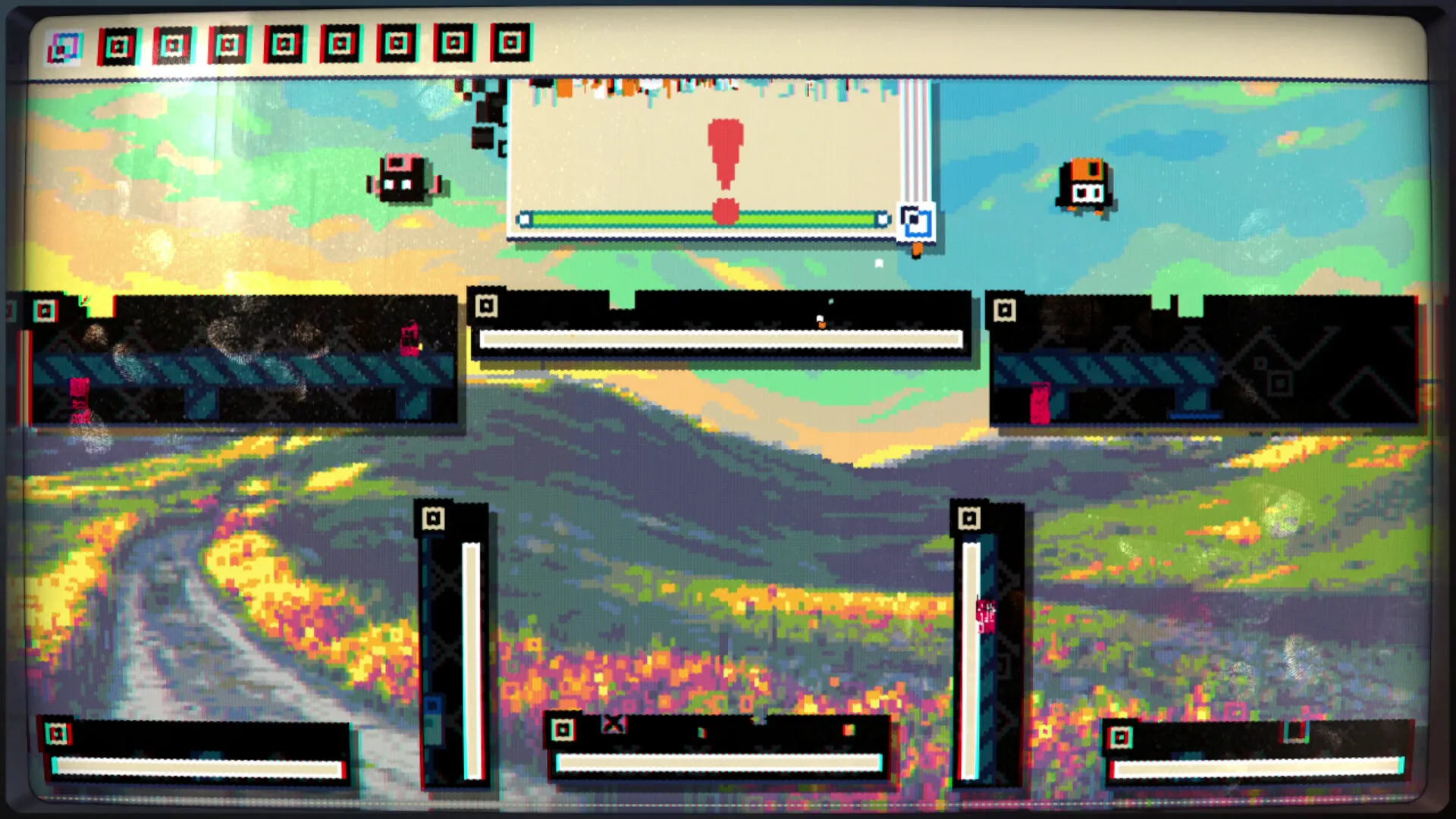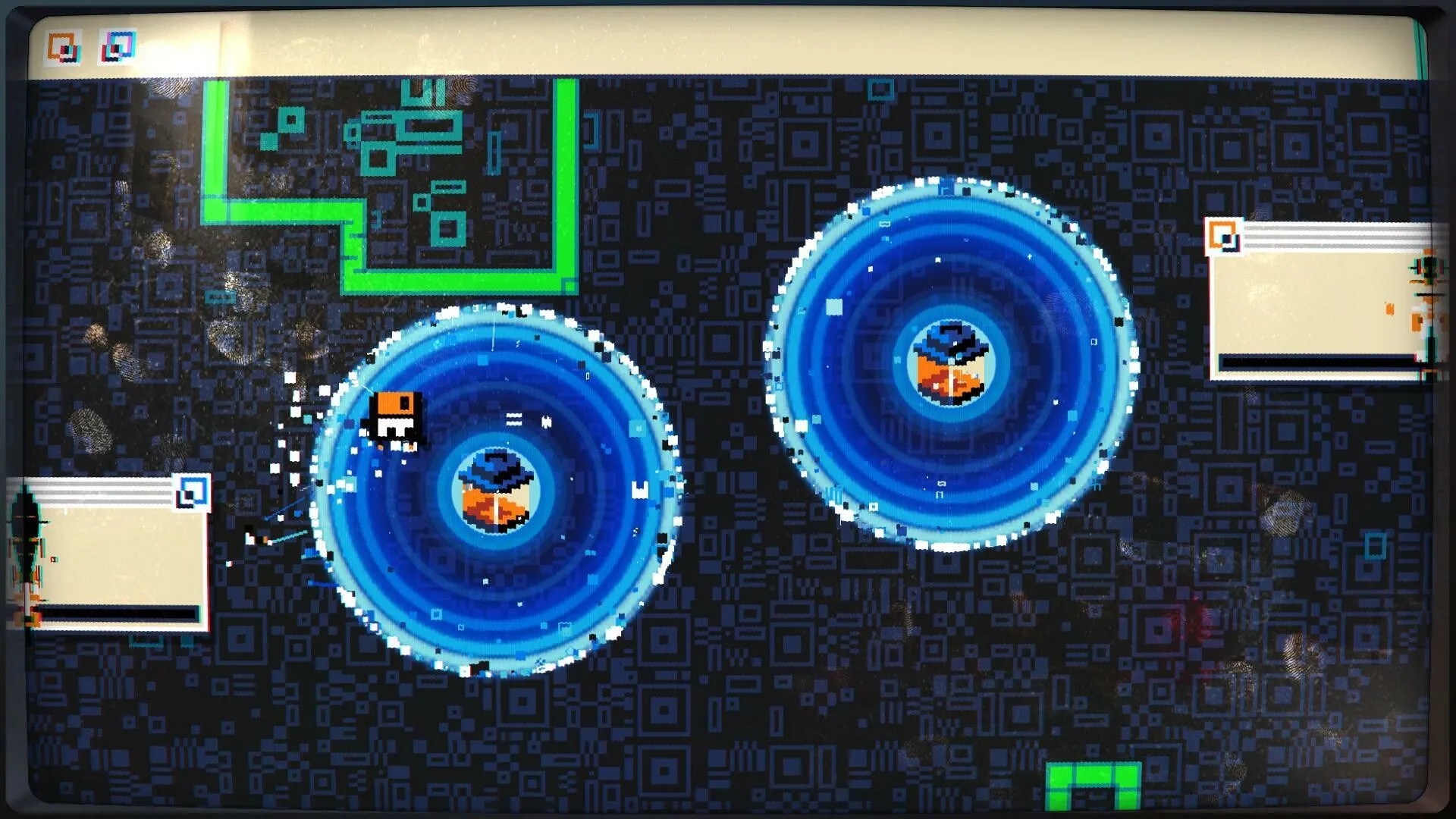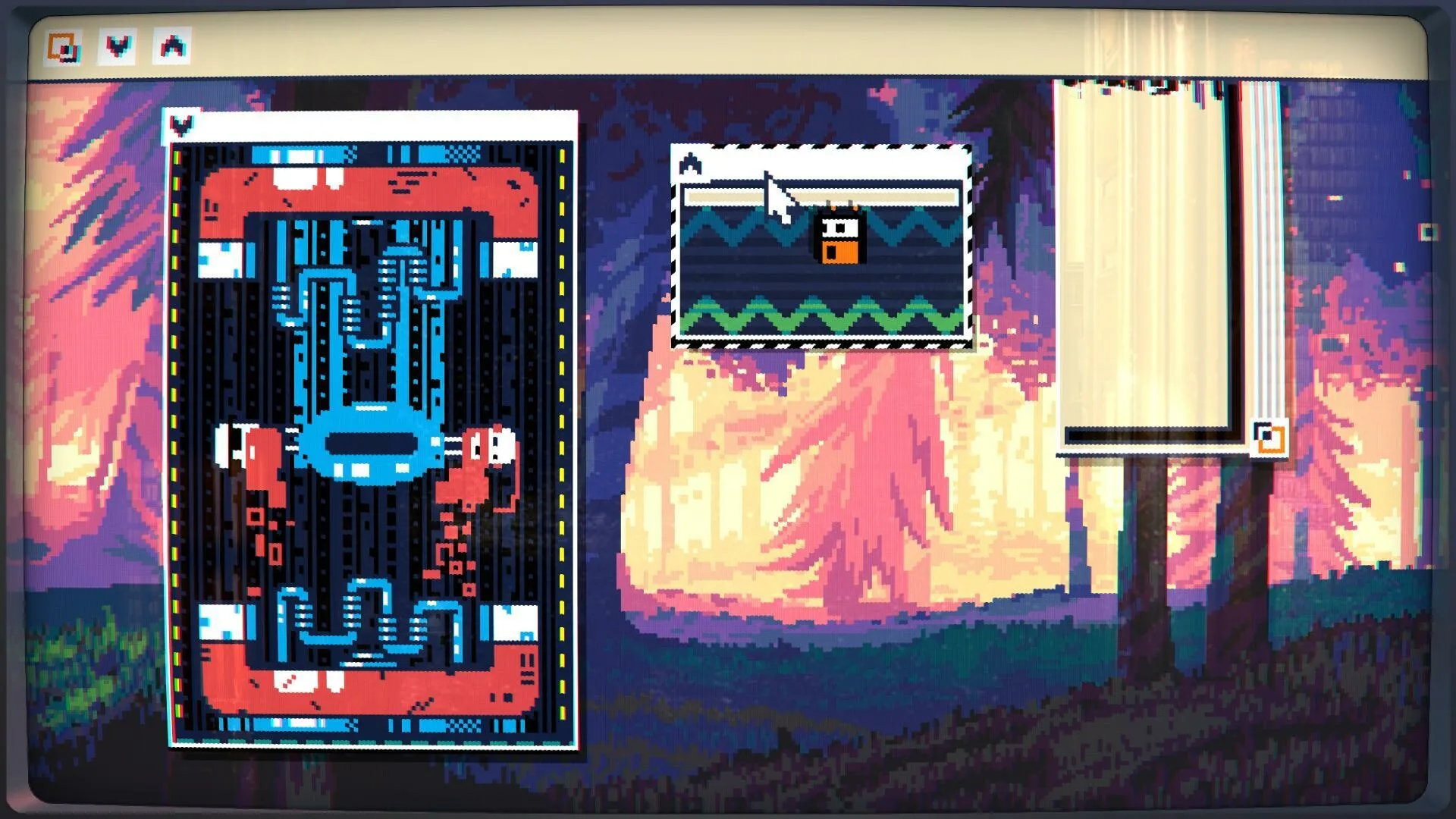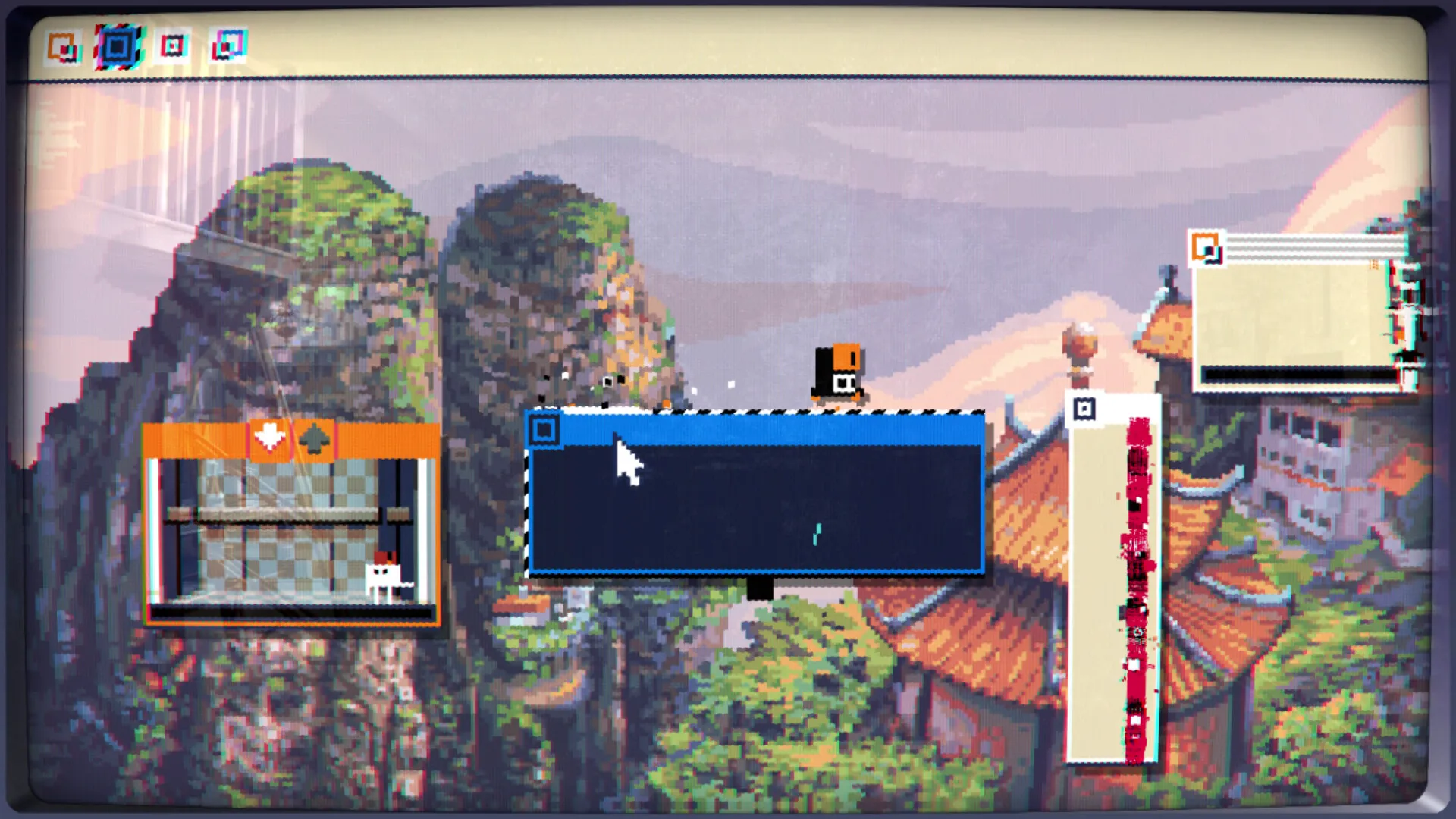The game opens with an inventive setting: a platformer unfolding inside a computer’s desktop. The structure of levels is formed by different “windows” or frames, each acting as a separate stage.
This concept transforms a familiar digital workspace into a play area governed by its own rules. The design reflects the inner workings of a computer, where every icon and interface element serves as both an obstacle and a tool.
At the center is Floppy, a charming, pixelated floppy disk tasked with restoring order to a malfunctioning system. His objective, whether it is to fix or escape a disordered digital world, is presented with both simplicity and creativity.
The game takes visual cues from early computer technology, featuring pixel art and effects reminiscent of CRT displays. This aesthetic, paired with inventive puzzles that involve altering computer windows, invites players to rethink the environment they usually take for granted.
The review will address gameplay dynamics, level construction, visual design, sound, narrative, and technical performance. While the storyline is minimal, the focus on inventive mechanics and atmospheric design ensures a memorable experience. Comparisons with other games in the genre highlight how MainFrames offers engaging challenges and a distinctive setting.
Mechanics and Control Precision in MainFrames
MainFrames employs straightforward movement elements such as running, jumping, mid-air spins, and wall-holding. The game requires careful timing and precise inputs, with every jump and spin demanding accurate control.
Players experience a level of responsiveness reminiscent of titles known for their precision platforming. The controls are designed to reward skillful play, with Floppy’s actions providing immediate feedback that enhances the gameplay.
A standout feature is the interaction with computer windows, which serve as both platforms and puzzle pieces. Some windows remain fixed while others shift or expand based on Floppy’s actions.
For example, running in place can trigger a window to enlarge, revealing a hidden key, and using mouse or analogue inputs causes certain windows to slide across the screen.
This dynamic element requires players to coordinate their character’s movement with the manipulation of the digital environment, adding a layer of strategy to the platforming challenges.
The integration of logic puzzles within the platforming framework enriches the experience further. Certain obstacles involve collecting keys by triggering concealed windows or activating icons that alter the stage layout.
There are moments when moving a platform or window correctly can open access to bonus areas or secret routes. These puzzles blend seamlessly with the basic movement mechanics, ensuring that each stage provides fresh challenges while maintaining a coherent structure.
The controls deliver a crisp feel that supports rapid and deliberate actions. There are instances where the difficulty escalates, particularly when the need for environmental manipulation coincides with precision jumps.
Some sequences, like those involving gravity inversion or sections where skipping parts of the level becomes a possibility, may challenge players unexpectedly. The availability of toggles such as infinite jumps and invulnerability accommodates various skill levels, ensuring that both experienced enthusiasts and newcomers can enjoy the platforming experience.
Level Architecture and Environmental Design
MainFrames arranges its game world into a series of clearly defined zones linked by a central hub. Players progress through seven or eight distinct levels, each representing a different aspect of a computer system.
One level might feel like traversing through the inner workings of a peripheral device, while another offers the visual complexity of a busy network. This arrangement gives each area its own character and challenge.
The design delivers a noticeable shift in visual style and gameplay obstacles as players move between levels. Some areas evoke a cluttered digital workspace reminiscent of an old operating system, while others present a cleaner, more modern interface. The variations in color schemes and layout elements signal to players that new challenges lie ahead, creating a sense of anticipation akin to what one might experience in other classic platformers.
Interactive elements play a significant role in shaping the experience. Many windows in the game function as both fixed platforms and moving pieces that alter the environment. For instance, some panels scroll or expand when the character is nearby, revealing hidden paths or essential items like keys. There are also screens that require deliberate manipulation to remove obstacles, echoing mechanics seen in titles that emphasize precision and timing.
Optional challenges are woven into the level design as well. Hidden areas and collectible digital sprites are placed in spots that encourage extra exploration. These secret sections offer additional puzzles that test the player’s control and timing, contributing to replay value. The pace of each level shifts from sections of rapid movement to areas that require careful planning and interaction with the environment, ensuring that the gameplay remains engaging throughout.
Visual and Sound Aesthetics
The game features retro pixel art that calls to mind classic computer displays. Its graphics replicate the look of early digital screens with effects resembling the soft glow and scan lines of CRT monitors.
Intentional color banding and the characteristic pixelated design of characters enhance the nostalgic feel. Small details, such as subtle fingerprints on screens and realistic reflections on monitor surfaces, contribute to the authenticity of the aesthetic.
Characters, including Floppy, the penguin guide, daemons, and processes, are designed to match this retro style. While the backgrounds are rendered with considerable detail and variety, the computer windows maintain a flatter appearance, creating a visual contrast that supports both clarity and style. This design choice emphasizes the dual nature of the game’s environment: rich and decorative backgrounds set against more straightforward interactive elements.
Animation plays a significant role in bringing the digital world to life. Both the protagonist and various interactive elements exhibit smooth, responsive motions that lend precision to gameplay. Small idle movements and responsive environmental reactions inject character into the digital space, ensuring that every element feels deliberate and alive.
The soundtrack, inspired by classic chiptune music, delivers a lively tone that matches the visual style. Sound effects such as well-timed boings, twirls, and ambient computer noises provide cues for player actions and accentuate the game’s thematic setting. While occasional visual glitches appear, these moments are rare and have little effect on the overall immersive experience created by the combined art and sound design.
Narrative and Character Dynamics
The story in MainFrames follows a straightforward arc centered around Floppy, a small, animated floppy disk caught in a malfunctioning computer system.
The narrative begins with a typical boot-up sequence that quickly turns chaotic, forcing Floppy to step into a world that has lost its normal order. This setup creates a framework where the disruption of a familiar digital environment becomes the catalyst for the action that follows.
Throughout the game, interactions with a limited cast of characters add texture to this framework. A notable character is a penguin inspired by the Linux mascot, who serves as a guide and provides practical advice during key moments.
Other digital denizens, such as quirky programs and wandering mascots, contribute brief exchanges that, while sparse, offer hints about the underlying state of the computer world. These moments of dialogue not only break the monotony of gameplay but also subtly provide context and backstory without overwhelming the primary focus on platform challenges.
Environmental cues further enrich the storytelling. Background elements like broken emails and displays of corrupted data serve as silent narrators, suggesting a history of decay and disruption within the system. Players observe the gradual degradation of the digital realm, a visual echo of the thematic tension between outdated technology and newer systems.
The narrative unfolds in short snippets between levels, offering enough context to inform players about the stakes while allowing them to focus on mastering the game’s challenges. The minimalistic storytelling invites personal interpretation, as players piece together the broader implications of the computer’s state through its visual and interactive elements.
Technical Performance and Accessibility Details
The controls deliver a crisp feel that supports rapid input and exact movements, reminiscent of platformers known for tight precision. However, there are moments when the response is less consistent—particularly during sequences that involve switching gravity or moving multiple elements at once.
Occasional slowdowns and minor visual issues, such as text merging into backgrounds or slight delays when loading levels, can interrupt the flow. These glitches, while infrequent, highlight areas where the technical execution could improve.
Difficulty fluctuates notably throughout the game. Some sections feature abrupt spikes that rely heavily on repeated trial and error, contrasting with smoother segments where the pace is more forgiving. This contrast can affect the player’s sense of progression, especially for those used to the steady challenge seen in other precision-based titles.
A range of accessibility options is available, including modes that allow infinite jumping and temporary invulnerability. Such features assist players who might struggle with sudden increases in difficulty, making the experience more approachable.
The user interface, however, suffers from the lack of clear maps or level markers. This omission makes exploring hidden content and alternate routes challenging, although it does encourage players to experiment and discover secret areas through exploration.
The Review
MainFrames
MainFrames delivers clever platforming, appealing retro graphics, and a playful narrative. The game presents a mix of precise control and inventive puzzle design. Occasional technical glitches and uneven challenge spikes are balanced by helpful accessibility options. Fans of tight platformers and digital aesthetics will appreciate its fresh twist on familiar themes.
PROS
- Precise and responsive controls
- Creative puzzle-platform mechanics
- Engaging digital-themed narrative
CONS
- Occasional control inconsistencies
- Minor technical glitches (slowdowns, text blending)




















































